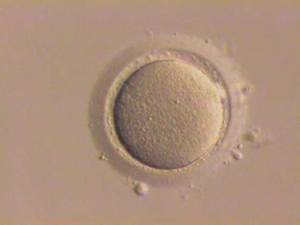Improving IVF
Interview with
Meera Senthilingam went along to meet Alison Murdoch who is the Professor of Reproductive Medicine at Newcastle Fertility Centre where she's been working ways to improve the chances of IVF actually working.
Alison - You have to start really from where IVF began. The first IVF treatment, it was over 30 years ago now and although it has improved, it's not made it a treatment that is going to be guaranteeing that every single woman who comes along is going to achieve a pregnancy. We're now expecting about a quarter of people who have one go at IVF to become pregnant. If women come along when they're a lot older, when their eggs are no longer of good quality, I'm afraid there's very little that we can do to help. But there's a lot that we can do, I think, to try and improve the techniques for IVF that we have at the present time.
Meera - So what are some of the limitations with regard to the IVF treatment itself when it comes to the creation of embryos or the health of the embryos?
 Alison - I think there's a lot that we can do to try and improve the way that embryos are actually grown within the laboratory. The standard techniques in the laboratory really haven't changed over the past 30 years. They involve handling embryos on a small dish, looking at them in a microscope, and then walking across the room with them putting them back into the incubator. Now obviously, potentially, the embryo is going to be harmed by being cooled as you walk across the room. Traditionally, people have said it's impossible to do it any other way. But the embryologists led by Mary Herbert in Newcastle have actually worked very hard at this and found that it is possible to provide an isolator system. That means basically, when the sperm that goes into an enclosed cabinet at the beginning of the IVF procedure, all the manipulation that are done, the checking of the embryo, the checking of the fertilization, the ICSI procedures, are all done within an enclosed system. So, that the embryo that comes out two days later has never been in contact with the air at all. It means that we can control its environment totally.
Alison - I think there's a lot that we can do to try and improve the way that embryos are actually grown within the laboratory. The standard techniques in the laboratory really haven't changed over the past 30 years. They involve handling embryos on a small dish, looking at them in a microscope, and then walking across the room with them putting them back into the incubator. Now obviously, potentially, the embryo is going to be harmed by being cooled as you walk across the room. Traditionally, people have said it's impossible to do it any other way. But the embryologists led by Mary Herbert in Newcastle have actually worked very hard at this and found that it is possible to provide an isolator system. That means basically, when the sperm that goes into an enclosed cabinet at the beginning of the IVF procedure, all the manipulation that are done, the checking of the embryo, the checking of the fertilization, the ICSI procedures, are all done within an enclosed system. So, that the embryo that comes out two days later has never been in contact with the air at all. It means that we can control its environment totally.
Meera - So, how does this new technology work exactly? So what are the various stages of it? And what are the conditions that you're controlling during this?
Alison - The core part of the conventional technology is an incubator that where the embryos grow for most of the time and a workstation where we do the manipulation, the insemination and checking the embryos. Conventional technology as these two are separated - in the new isolated technology, they're actually directly joined to each other so you can move from the working area directly to the incubator and directly back into the working area again. That means that the air in which the embryo is growing is constant. It never changes. It doesn't matter what's happening in the outside air. It will stay exactly the same. So we can control the temperature, we can control the gas concentration that's in the media. We can make sure that it's absolutely clean at all times.
Theoretically, that might make better embryos and the results that we've had because we've been working with this technology now for over 18 months, does seem to suggest that we'll likely to get better embryos because we're getting more pregnancies.
Meera - So, what is the temperature then that you operate at? And what are these gases that you're controlling? And how are these benefiting the growth of the embryo?
 Alison - Normal body temperature would be 36 to 37 degrees. We did some experiments in the conventional system where you put a little micro probe to measure the temperature within the dish while it's sitting under the microscope. Under those circumstances, it's on the heated block and there's heated air, but there's a cooling effect. And within two or three minutes, the fluid that those embryos are lying in will cool down to maybe 32 degrees, that's very cold for body temperature. That's why embryologists have to work really quickly when they're looking at the embryos. They want them out with as little time as possible and get them back. That doesn't give them time to spend the time looking carefully at the embryos to grade them more accurately. So, by controlling the temperature the whole time, they can take as long as they want to make sure that they got - they're doing exactly the absolutely the right thing for the embryo.
Alison - Normal body temperature would be 36 to 37 degrees. We did some experiments in the conventional system where you put a little micro probe to measure the temperature within the dish while it's sitting under the microscope. Under those circumstances, it's on the heated block and there's heated air, but there's a cooling effect. And within two or three minutes, the fluid that those embryos are lying in will cool down to maybe 32 degrees, that's very cold for body temperature. That's why embryologists have to work really quickly when they're looking at the embryos. They want them out with as little time as possible and get them back. That doesn't give them time to spend the time looking carefully at the embryos to grade them more accurately. So, by controlling the temperature the whole time, they can take as long as they want to make sure that they got - they're doing exactly the absolutely the right thing for the embryo.
Meera - And now you mentioned also that the gas concentrations are controlled, so which gases are controlled? And what effect can this have on the embryo growth?
Alison - All gases are controlled. We need to make sure, first of all, that the carbon dioxide level is accurate. This is because the acidity in fluid is controlled by carbon dioxide. And if we have the wrong concentration of carbon dioxide, the fluid that the embryos are in can become too acid and can harm them. We also need to make sure the oxygen tension is right. In the body, the oxygen concentration might be about 5% whereas, in the air, it's 20%. We really don't know what harm that change would have in culturing embryos. But within an enclosed system we kind, of course, control that precisely and make absolutely sure that we have as near body concentration as possible.
Meera - There must be, I mean, there's obviously a slight exposure to the natural environment between having made these embryos and then implanting into the women but I assume that's a very small gap then and that will be accounted for too.
Alison - Yes, obviously, when the embryo comes out of the incubators for it to finally to go back into the patient, it's got to happen that way. What we do though is we put the embryos into a very fine catheter. The embryologist is sitting next to the patient. It's handed to the doctor or the nurse to put back into the patient and it literally will take a few seconds as it crosses the room. So I don't think that's an area we could do much about.
Meera - And so, how much is this technology in use at the moment so, and is it likely to expand and be used in more clinics?
Alison - Well, it's still is very new and ours is the is the first system but there are other units now in Europe as well who are buying and investing in it. I think this is the way it will go because, intuitively, it has to be better. If you had an embryo, your embryo, would you want it to be subjected to the external environment or would you want it to be in an enclosed system where you can control it completely? And any embryologist would say, it has to be theoretically better. It's early days to see the impact on the quality of the embryos and pregnancy rates. We'll publish the data when we've got it completed.
Chris -Alison Murdoch who's from the Newcastle Fertility Centre and she was talking to Meera Senthilingam at the fertility show in London earlier this week.










Comments
Add a comment